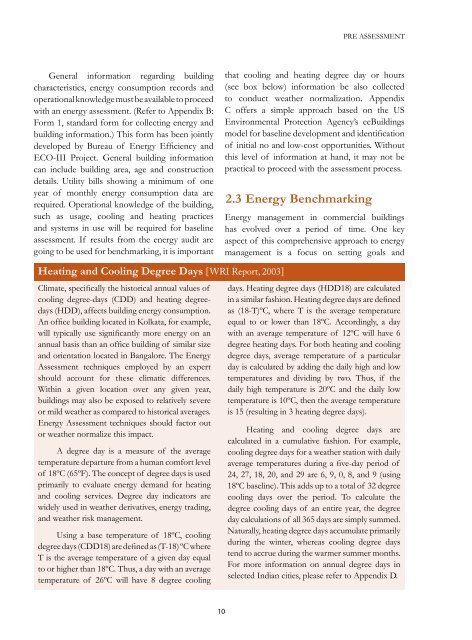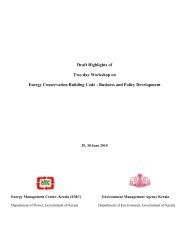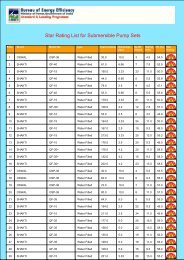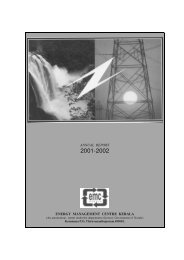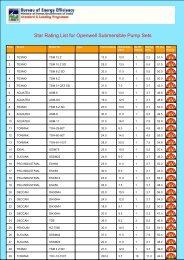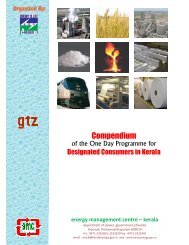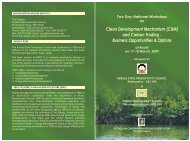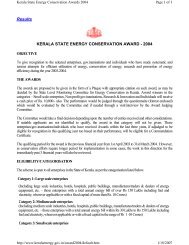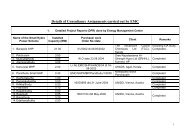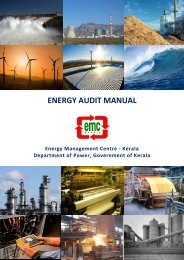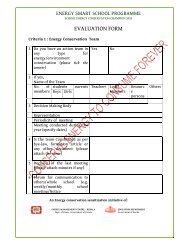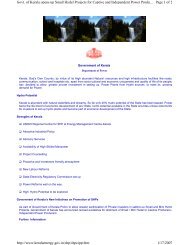energy assessment guide for commercial buildings - ECO-III
energy assessment guide for commercial buildings - ECO-III
energy assessment guide for commercial buildings - ECO-III
Create successful ePaper yourself
Turn your PDF publications into a flip-book with our unique Google optimized e-Paper software.
PRE ASSESSMENT<br />
General in<strong>for</strong>mation regarding building<br />
characteristics, <strong>energy</strong> consumption records and<br />
operational knowledge must be available to proceed<br />
with an <strong>energy</strong> <strong>assessment</strong>. (Refer to Appendix B:<br />
Form 1, standard <strong>for</strong>m <strong>for</strong> collecting <strong>energy</strong> and<br />
building in<strong>for</strong>mation.) This <strong>for</strong>m has been jointly<br />
developed by Bureau of Energy Efficiency and<br />
<strong>ECO</strong>-<strong>III</strong> Project. General building in<strong>for</strong>mation<br />
can include building area, age and construction<br />
details. Utility bills showing a minimum of one<br />
year of monthly <strong>energy</strong> consumption data are<br />
required. Operational knowledge of the building,<br />
such as usage, cooling and heating practices<br />
and systems in use will be required <strong>for</strong> baseline<br />
<strong>assessment</strong>. If results from the <strong>energy</strong> audit are<br />
going to be used <strong>for</strong> benchmarking, it is important<br />
that cooling and heating degree day or hours<br />
(see box below) in<strong>for</strong>mation be also collected<br />
to conduct weather normalization. Appendix<br />
C offers a simple approach based on the US<br />
Environmental Protection Agency’s eeBuildings<br />
model <strong>for</strong> baseline development and identification<br />
of initial no and low-cost opportunities. Without<br />
this level of in<strong>for</strong>mation at hand, it may not be<br />
practical to proceed with the <strong>assessment</strong> process.<br />
2.3 Energy Benchmarking<br />
Energy management in <strong>commercial</strong> <strong>buildings</strong><br />
has evolved over a period of time. One key<br />
aspect of this comprehensive approach to <strong>energy</strong><br />
management is a focus on setting goals and<br />
Heating and Cooling Degree Days [WRI Report, 2003]<br />
Climate, specifically the historical annual values of<br />
cooling degree-days (CDD) and heating degreedays<br />
(HDD), affects building <strong>energy</strong> consumption.<br />
An office building located in Kolkata, <strong>for</strong> example,<br />
will typically use significantly more <strong>energy</strong> on an<br />
annual basis than an office building of similar size<br />
and orientation located in Bangalore. The Energy<br />
Assessment techniques employed by an expert<br />
should account <strong>for</strong> these climatic differences.<br />
Within a given location over any given year,<br />
<strong>buildings</strong> may also be exposed to relatively severe<br />
or mild weather as compared to historical averages.<br />
Energy Assessment techniques should factor out<br />
or weather normalize this impact.<br />
A degree day is a measure of the average<br />
temperature departure from a human com<strong>for</strong>t level<br />
of 18ºC (65ºF). The concept of degree days is used<br />
primarily to evaluate <strong>energy</strong> demand <strong>for</strong> heating<br />
and cooling services. Degree day indicators are<br />
widely used in weather derivatives, <strong>energy</strong> trading,<br />
and weather risk management.<br />
Using a base temperature of 18ºC, cooling<br />
degree days (CDD18) are defined as (T-18) ºC where<br />
T is the average temperature of a given day equal<br />
to or higher than 18ºC. Thus, a day with an average<br />
temperature of 26ºC will have 8 degree cooling<br />
days. Heating degree days (HDD18) are calculated<br />
in a similar fashion. Heating degree days are defined<br />
as (18-T)ºC, where T is the average temperature<br />
equal to or lower than 18ºC. Accordingly, a day<br />
with an average temperature of 12ºC will have 6<br />
degree heating days. For both heating and cooling<br />
degree days, average temperature of a particular<br />
day is calculated by adding the daily high and low<br />
temperatures and dividing by two. Thus, if the<br />
daily high temperature is 20ºC and the daily low<br />
temperature is 10ºC, then the average temperature<br />
is 15 (resulting in 3 heating degree days).<br />
Heating and cooling degree days are<br />
calculated in a cumulative fashion. For example,<br />
cooling degree days <strong>for</strong> a weather station with daily<br />
average temperatures during a five-day period of<br />
24, 27, 18, 20, and 29 are 6, 9, 0, 8, and 9 (using<br />
18ºC baseline). This adds up to a total of 32 degree<br />
cooling days over the period. To calculate the<br />
degree cooling days of an entire year, the degree<br />
day calculations of all 365 days are simply summed.<br />
Naturally, heating degree days accumulate primarily<br />
during the winter, whereas cooling degree days<br />
tend to accrue during the warmer summer months.<br />
For more in<strong>for</strong>mation on annual degree days in<br />
selected Indian cities, please refer to Appendix D.<br />
10


